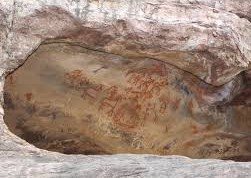Indian Dickinsonia Fossil
Indian scientists have made a groundbreaking discovery regarding the Indian Dickinsonia fossil, originally reported from the UNESCO World Heritage Site Bhimbetka Cave Shelter. Through meticulous research and analysis, they have revealed a surprising revelation that challenges previous assumptions.
Examining the Indian Dickinsonia Fossil
A team of Ediacaran palaeontologists from the Birbal Sahni Institute of Palaeosciences (BSIP) undertook a comprehensive scrutiny of the fossil known as Dickinsonia tenuis. This particular fossil, an important Ediacaran fossil, sparked curiosity after American scientists reported another Ediacaran fossil in the same area.
Unveiling the Truth
Through extensive field observations and laboratory analyses, the scientists discovered evidence that contradicts the earlier claims. The fossil did not exhibit the expected characteristics of biogenicity and syngenecity. Instead, it was identified as a left-over impression of a fallen beehive. This revelation disproves the initial interpretation given by renowned American researchers.
Evidence from the Site
During their investigation, the team found compelling evidence at the site of the claimed fossil. The presence of fresh and decayed honey beehives, along with bees and honeycomb structures, raised doubts about the fossil’s true identity. This observation strongly suggested that the described fossil was misinterpreted as Dickinsonia.
Confirmation through Advanced Techniques
To substantiate their findings, the researchers utilized advanced techniques such as Laser Raman Spectroscopy and X-Ray Diffraction (XRD). These methods confirmed the presence of honey and wax in the material, providing further support for their conclusion.
Importance of Correct Interpretation
The correction of misinterpretations in the study of Indian geology holds immense importance. It allows scientists to trace the exact evolutionary trail and gain a comprehensive understanding of the Earth’s geological history. By challenging previous assumptions and presenting accurate information, researchers can uncover new insights into the origins and diversification of life.
Vindhyan Supergroup: Unveiling Earth’s History
The Vindhyan Supergroup, renowned for being an archive of over one billion years of Earth’s history, plays a crucial role in such discoveries. This vast basin holds significant fossil discoveries that shed light on the origins and diversification of life on our planet. The exploration of this site contributes to our understanding of how the earliest life forms emerged and adapted.
Month: Current Affairs - June, 2023
Category: India Nation & States Current Affairs


